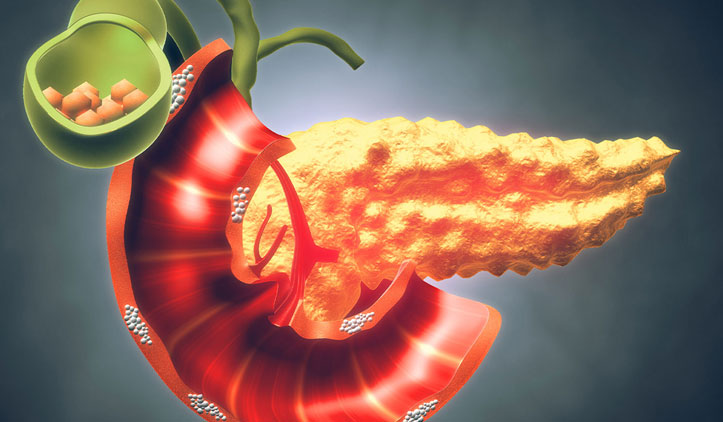Pancreatic Cancer

What Is the Pancreas?
The pancreas is a spongy, tube-shaped organ about 15 cm long. It is located in the back of the abdomen, behind the stomach. The head of the pancreas is on the right side of the abdomen. It is connected to the duodenum, the upper end of the small intestine. The narrow end of the pancreas, called the tail, extends to the left side of the body.
What Is Pancreatic Cancer?
Pancreatic cancer develops when abnormal cells in the pancreas begin to grow uncontrollably, forming either benign or malignant tumours. In Singapore, it ranks as the fourth leading cause of cancer death among women and the third among men, highlighting its aggressive nature and serious impact in recent years.
What Are the Symptoms of Pancreatic Cancer?
Pancreatic cancer has been called a "silent" disease because early pancreatic cancer usually does not cause symptoms. Symptoms typically appear only after it begins to affect nearby organs. Even when it spreads to the liver, abdominal wall, lungs, bones, or lymph nodes, it is still classified as pancreatic cancer, as the disease originated in the pancreas.
If the tumour blocks the common bile duct and bile cannot pass into the digestive system, the skin and whites of the eyes may become yellow, and the urine may become darker. This condition is called jaundice.
As the cancer grows and spreads, pain often develops in the upper abdomen and sometimes spreads to the back. The pain may become worse after the person eats or lies down. Cancer of the pancreas can also cause nausea, loss of appetite, weight loss, and weakness. Other symptoms of advanced pancreatic cancer may include:
- Bloating
- Itchy skin
- Nausea and vomiting
- Recent diagnosis of diabetes
- A blood clot in an arm or leg that causes pain and swelling
What Are the Risk Factors for Pancreatic Cancer?
Several factors can increase an individual's likelihood of developing pancreatic cancer:
- Tobacco Use
- Chronic pancreatitis
- Type 2 diabetes
- Being overweight or obese
- Chemical exposure
- Being male
- Age over 45
- Family history of inherited genetic mutations
What Are the Types of Pancreatic Cancer?
Pancreatic cancer is generally classified into two major categories based on the type of cells where the tumour originates:
- Exocrine Pancreatic TumoursThe vast majority of pancreatic cancers are exocrine. These cancers typically begin in the cells that produce digestive enzymes. Exocrine tumours tend to be aggressive, are often diagnosed at advanced stages, and require swift, intensive treatment.
- Pancreatic Neuroendocrine Tumours (PNETs)Neuroendocrine tumours arise from the hormone-producing islet cells of the pancreas. PNETs typically grow at a slower pace than exocrine cancers and may offer more treatment options depending on the tumour’s activity and spread.
How Is Pancreatic Cancer Diagnosed?
To diagnose pancreatic cancer, the doctor does a complete physical exam and asks about the patient's personal and family medical history. Other tests may be ordered, such as CT scans and X-rays, which give detailed pictures of a cross-section of the pancreas. A biopsy is the only sure way for the doctor to know whether cancer is present. In a biopsy, the doctor removes some tissue from the pancreas. It is examined under a microscope by a pathologist, who checks for cancer cells.
Pancreatic cancer can be hard to detect early. If you have risk factors or concerns, schedule a consultation with our pancreatic cancer specialist for a thorough evaluation.
What Are the Stages of Pancreatic Cancer?
As with all types of cancer, staging of pancreatic cancer is crucial for doctors to form the most effective treatment strategy. It helps assess how advanced the disease is, including the tumour’s size, whether it has spread, and most importantly, if it is resectable (it can be safely removed through surgery). This information guides both immediate decisions and long-term care planning.
Stage 0
This is the earliest form, where abnormal but non-invasive cells are detected within the inner lining of the pancreatic ducts. Although not yet cancerous, they have the potential to evolve if left untreated.
Stage I
At this point, the tumour is still restricted to the pancreas and measures 4 centimetres or smaller. It has not infiltrated nearby structures or lymph nodes, making it one of the more operable stages if caught early.
Stage II
The tumour may have grown larger than 4 centimetres and could have started to press against or lightly invade surrounding tissue. While still potentially resectable, this stage begins to hint at more aggressive behaviour.
Stage III
The cancer has reached 4 or more lymph nodes or wrapped around crucial blood vessels and nerves near the pancreas. While the tumour may not have travelled far from the original site, surgical removal becomes more difficult, often requiring complex treatment strategies.
Stage IV
This is the most advanced stage, where cancer cells have broken free and established themselves in distant organs such as the liver, lungs, or the abdominal lining. At this point, the disease is typically inoperable and is managed primarily with systemic therapies to slow its spread and relieve symptoms.
What Treatment Options Are Available for Pancreatic Cancer in Singapore?
Cancer of the pancreas is curable only when it is found in its earliest stages, before it has spread. Otherwise, it is very difficult to cure. However, it can be treated, symptoms can be relieved, and the quality of the patient's life can be improved. Pancreatic cancer is treated with surgery, radiation therapy, or chemotherapy.
Surgery
Surgery may be done to remove all or part of the pancreas. Sometimes it is also necessary to remove a portion of the stomach, the duodenum, and other nearby tissue. There are three types of pancreatic surgery available in Singapore:
- Whipple Procedure (Pancreaticoduodenectomy)This intricate pancreatic surgery involves the removal of several structures at once: the head of the pancreas, the initial segment of the small intestine (called the duodenum), the gallbladder, a part of the bile duct, and nearby lymph nodes.
- Distal PancreatectomyIn this operation, the surgeon removes the tail of the pancreas along with a portion of its body. The spleen, which is closely linked to this part of the pancreas, is typically removed as well.
- Total PancreatectomyA total pancreatectomy is a radical surgery that removes the entire pancreas along with the gallbladder, spleen, and parts of the stomach and small intestine. Without the pancreas, the body can no longer produce insulin or digestive enzymes. Lifelong insulin therapy and enzyme supplementation will be needed.
Radiation
Radiation therapy (also called radiotherapy) uses high-powered rays to damage cancer cells and stop them from growing. Radiation is also used as a way to kill cancer cells that remain in the area after surgery.
Chemotherapy
Chemotherapy uses drugs to kill cancer cells. The doctor may use just one drug or a combination. Chemotherapy may be given by mouth or by injection into a muscle or vein. The drugs enter the bloodstream and travel through the body.
Our Pancreatic Cancer Doctor in Singapore
Dr Tay Khoon Hean MBBS (Singapore), FRCS (Glasgow), FRCS (Edinburgh),FICS (USA) FAMS (General Surgery)
Dr Tay is a general surgeon with subspecialty training in hepatopancreatobiliary (HPB) and minimally invasive surgery. He holds dual surgical fellowships from the Royal College of Surgeons in Edinburgh and Glasgow, and underwent advanced HPB training at Pontchaillou Hospital, Université de Rennes in France. His clinical work includes pancreatic resections such as pylorus-preserving pancreatoduodenectomy (PPPD) to treat cancers of the head of pancreas.

Frequently Asked Questions
Is pancreatic cancer curable?
Pancreatic cancer may be curable with surgery if it is detected at an early stage and has not spread.
What is the life expectancy for someone with pancreatic cancer?
Pancreatic cancer survival rates are generally low. Because early-stage pancreatic cancer often shows no obvious symptoms, most cases are diagnosed too late for surgical removal.
Why is pancreatic cancer often diagnosed late?
Pancreatic cancer is often diagnosed late because early symptoms are vague or absent. Most signs only appear after the cancer has spread to other organs.

Request For An Appointment
Tay Khoon Hean Surgery is located in the Gleneagles Medical Centre. The clinic and its friendly, caring and dedicated staff offer a comprehensive service in all aspects of General Surgery. The clinic provides a comfortable and warm waiting area with a fully equipped treatment facility for minor surgical procedures.


